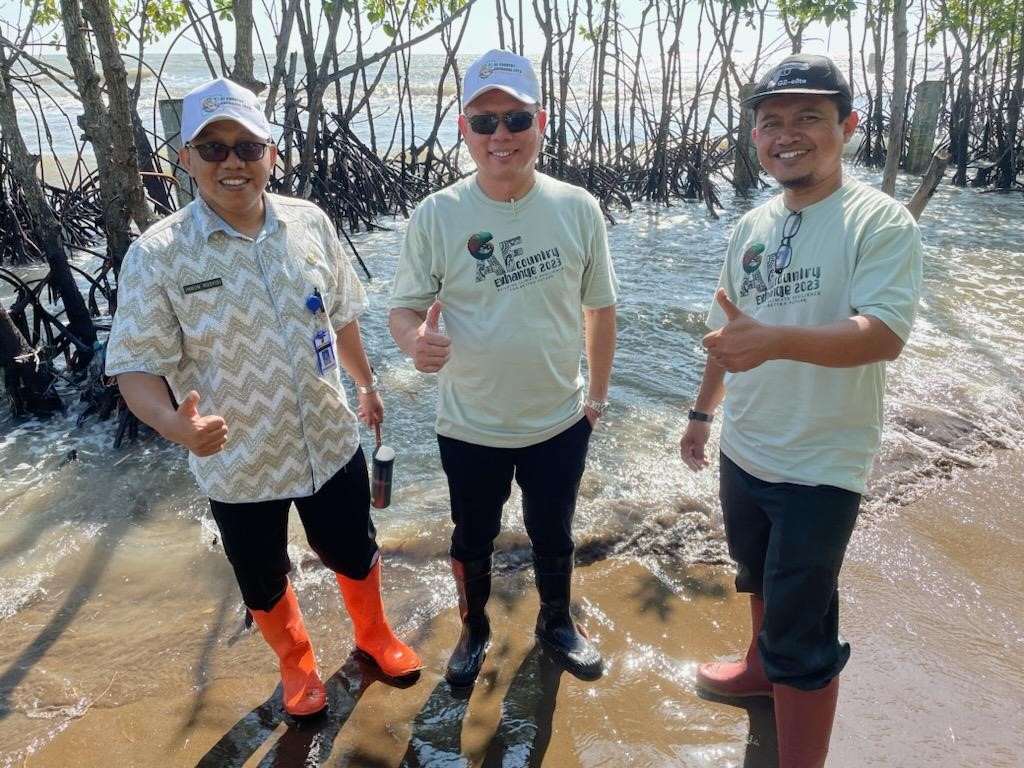Visit to the AF-funded project in Pekalongan implemented by Kemitraan. The project is developing innovative and novel interventions to adapt to sea level rise, including mangrove restoration, construction of wave deflection barriers, and creation of environmentally-friendly livelihoods and tools to build resilience against climate change. (Photo by AF)
Fighting Rising Seas and Sinking Lands in Indonesia with Adaptation Resolve and Ingenuity
Adaptation Fund Country Exchange Shows Strengthened Resilience on Java Coast
Semarang and Pekalongan, Central Java, Indonesia (June 5-9, 2023) — When the Adaptation Fund (AF) and co-host Kemitraan, the Fund’s national implementing partner in Indonesia, brought together local government leaders and 20 of the Fund’s national implementing entities (NIEs) from across the globe to meet in Central Java in early June for a knowledge exchange and visit to an AF-funded project in Pekalongan City, the visible impacts of sea level rise on the seaside community were jaw-dropping.
At high tide every day a good portion of the city is submerged. With the sea rising an average of 3-5 cm a year due to climate change, combined with the challenge of sinking land (another 11 cm a year) due to groundwater extraction, more than a third of Pekalongan City has been flooded since 2009. The coastline has shifted significantly. Tightly fit homes have resorted to packing sand to raise their floors up out of the flood zone, making their already small living spaces ever so tighter as they creep slowly toward the ceiling. In an even starker sight, the sea has surrounded an aging crematorium in a remaining spit of beach as waves continue to encroach past a fading line of soldierly but battered mangroves.
AF drone footage of Pekalongan flooding from tidal and sea rise impacts.
Once thriving rice paddies that supported the traditional food staple and flourishing jasmine fields have disappeared under the ocean, forcing local farmers to first try raising fish in enclosed ponds which in turn became flooded. Now they are resorting to line and boat fishing.
As many inland ponds become submerged, silvofishery and aquaculture farms have also cropped up to try to gradually adapt various species to the saltwater intrusions happening across the city.
“This is a really good example of the impact of climate change, especially in Java, the northern part of coastal Java, but the most impacted actually is Pekalongan,” said Dr. Laode M. Syarif (PhD), Executive Director of Kemitraan (short for the Partnership for Governance Reform), standing on a narrowing clip of beach in Pekalongan as high tide starts to seep through a nearby tangle of mangrove forest. Just off the coast are visible tips of mangroves that have been overrun by the sea. “The sea level rise per year is 3-4 cm, but also combined with land subsidence, it just makes it more devastating for the people as you can see. This used to be a (rice) paddy field and also jasmine plantations. Now it is actually under the water.”
The main destination of the visit, the nearly US$ 6 million AF-funded project being implemented by Kemitraan in Pekalongan, is trying to turn these challenges into tangible actions while creating new livelihoods.
Using a “3-S approach”, the project lives by the principles of Safekeeping, Surviving, and Sustaining, and has a mix of technical and nature-based components.
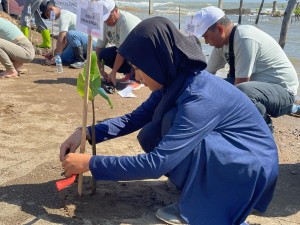
Sekar, from Kobar youth group, planting mangrove sapling. (Photo by AF)
It is constructing large wave deflection berms made of concrete and rock spaced apart offshore to create natural breakwaters and restore beach sediment, combined with mangrove planting and monitoring (implemented with help from local youth groups). Kemitraan hopes to start with two berms and eventually expand to five and save what is left of the coast and restore space for a mangrove ecotourism center. “It will catch the sediment so the sediment will slow down the land subsidence and when we get the sediment (back) we can actually plant the mangrove, and the breakwaters will reduce the impact of the currents and wave from the ocean,” said Syarif.
The project also utilizes many novel approaches, such as applying natural resources like thick bamboo poles to place mangrove plants high up within the poles, so they aren’t washed away in rising tides and floods. Side cut-outs are made for their roots to grow outward. “We will not only plant the mangroves, but we are actually strengthening them with bamboo poles so it will withstand the current,” Syarif added. “We try. It’s a new way.”
The sheer enormity of the visible sea level rise incursions in Pekalongan City and the innovations being applied to adapt seemed to leave a lasting impact on attendees, who took part in the visit as part of AF’s 4th Country Exchange to further its community of practice of NIEs by sharing best practices and lessons learned in countries implementing projects through Direct Access — which builds country ownership in adaptation. The exchange included a few days of workshops in Semarang, followed by the visit to the project in Pekalongan, reached after a few hours’ bus ride past rice paddy fields and wooded countryside.
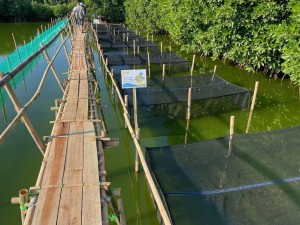
Creating new aquaculture fish farming models. (Photo by AF)
“I am left really impacted how that each year the water level is rising more than 10 cm, it is critical,” said Pamela Reyes, an innovation and strategic management specialist at Profonanpe, AF’s accredited NIE in Peru. “Climate change affects us all. It seems to be a great opportunity to be able to see how these distinct countries in distinct contexts come with their own strategies and in some cases can be very similar but also how to adapt in particular circumstances and how we manage the projects to obtain the best results.”
“Over the last five days, the country exchange program with the kind of cross-learning that has happened between the participants both from other countries and of course Kemitraan-Indonesia has been really wonderful,” added Sanjoy Ghosh, General Manager of the National Bank for Agriculture and Rural Development, AF’s NIE in India. “We can strongly relate that to many places in India (in states with large river deltas and tidal areas). That bamboo structure does open new possibilities. The kind of monitoring mechanism that we have learned about, too, would also be very useful.”
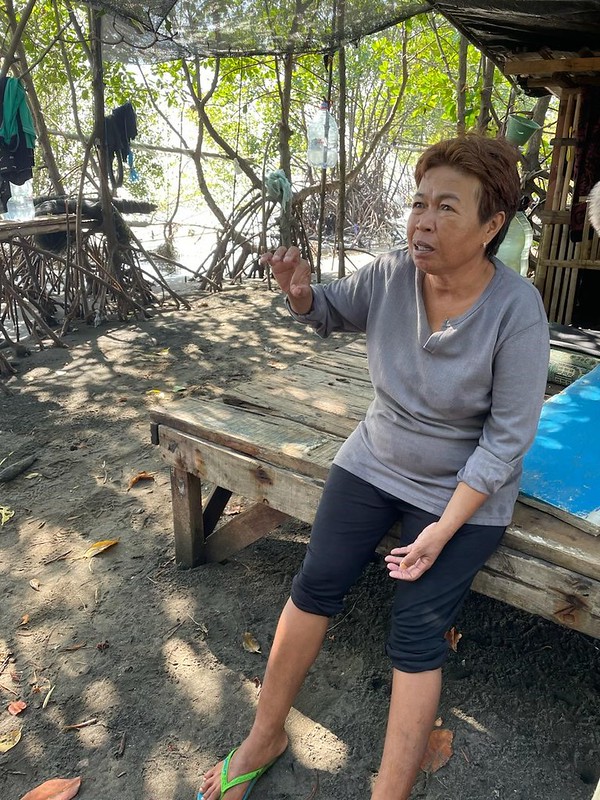
Siyamsih has been impacted by sea rise moving the coastline further inland. (Photo by AF)
“We had not been able to hold the country exchanges in-person the last couple of years due to the pandemic, so this first one back in Indonesia was really a fantastic learning experience for all involved,” said Mikko Ollikainen, Head of the AF. “Piloting and sharing effective adaptation solutions is a key pillar of the Adaptation Fund’s work. They are being hit hard here by sea level rise, and Kemitraan did a really great job in sharing the innovations they are applying to adapt through the project and all the NIEs shared their own experiences, as well. It will ultimately help enhance ways in which we collectively respond to climate change.”
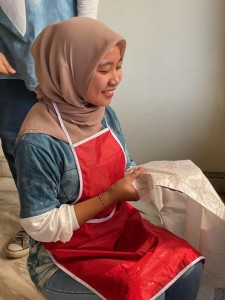
Sustainable and alternative livelihoods, such as environmentally-friendly batik printmaking, are being created in Pekalongan through the AF project. (Photo by AF)
Anita Heru Kusumorini, Acting Secretary of the City of Pekalongan, said the city was very grateful for the visit and learning that took place, adding that the project has drawn interest from city, provincial and national governments as the community continues to adapt to climate change in new and replicable ways.
Many sustainable and alternative livelihoods are being created in Pekalongan through the project, as well, such as establishing markets for environmentally-friendly prints on traditional batik fabrics; innovative urban and fish farming; as well as aquaculture and silvofishery nurseries raising milkfish, crab and certain fish species in isolated tanks and lined ponds and gradually exposing them to survive in salt water.
“The livelihood of the people in the past was farmers actually planting, so now it is quite difficult to change them to become traders,” Syarif said. “We may now try hydroponic urban farming instead, climbing up to the roofs instead of land-based. We also are trying fish farming. We work closely with universities here for a new aquaculture model with new species of fish.”
The project is helping in other ways. It is flood-proofing public sanitation facilities by raising the level of cleanwater faucets and drainage pathways; adding remote weather monitoring stations and early warning notification services through social media platforms; and raising awareness of adaptation through climate change working groups and youth involvement. It monitors the city’s most vulnerable areas through a unique climate risk analyses called SIDIK (Vulnerability Index Data Information System) that includes ongoing coastal and participatory climate risk assessments.
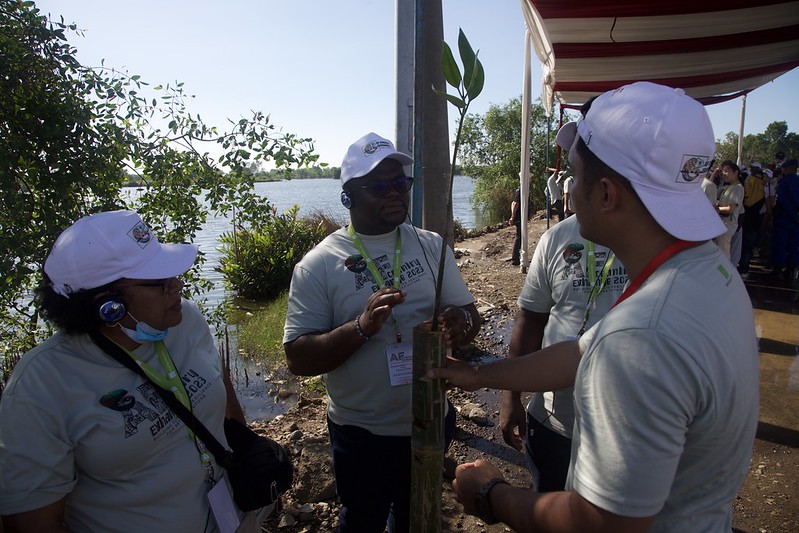
Novel bamboo structure protects mangrove plants. (Photo by AF)
It is hoped that many approaches being piloted through the project will be replicated or scaled up in the future. “There is a knowledge component in this project, that it is very important for the community to learn how to adapt to current conditions from the impact of climate change in Pekalongan,” said Ms. Dewi Rizki, Program Director of Kemitraan’s Sustainable Development Group.
Rizki points to the project’s example of creating a higher quality and sustainable market for jobs by training 400 of the next generation of batik makers throughout Pekalongan (also known as ‘Batik City’) on how to use natural dyes and zero waste in the artistic handwritten and handstamped prints on the popular fabrics and dresses found in Pekalongan’s open markets. “We send the youth of Pekalongan City that is involved in the project to actually study how to dye batik using natural color,” she said. “Economically we are going to push the government to find a link for a special price and (niche) market. This is a new thing of how to make color. The knowledge of preparing natural color (from local indigo plants) is helping to make a breakthrough for the batik makers. If this is successful, we could show to the government that this way could be done.”
The process preserves the environment, too. “Due to sea level rise and floods coming into batik production houses, all the artificial color made all the flood water turn red,” Rizki said. “The whole program could actually remind people that by using natural color with zero waste that kind of catastrophe won’t happen anymore.”
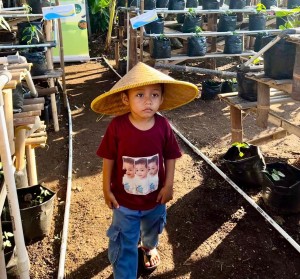
Urban rooftop hydroponic farming. (Photo by AF)
One thing that stood out throughout the project visit was the resiliency and positive attitude of the impacted Indonesian communities, as well as the involvement and shared responsibility of the next generation in the caretaking of the city.
As she carefully planted and tied a couple of mangrove saplings to posts on a small stretch of beach, Sekar – a girl from a community youth group (Kobar) that helps to plant and maintain mangroves in the project – said they are trying to plant Rhizophoras that are strong and can withstand the elements. She said they check and clean them monthly.
Down the beach amid a clearing of palm trees and mangroves, Siyamsih, a local resident who has been living from a small makeshift farm and bamboo hut on the island for many years with her husband Jumani, a mangrove farmer who provides seeds and helps maintain the nursery, is hopeful the project will help restore the beach. They have seen the coastline move further inland many times due to sea level rise over the years.
Just a short bus ride away from the shoreline into the center of Pekalongan where high tide floods much of its streets and the December-March rainy season leaves great parts of the area partially submerged, Juri, a construction laborer, says he has had to raise the floor of his very small home with packed sand four times since 2010 to counter a one-meter rise in water. He lives there with his partner while his six kids live apart with in-laws. When asked if he had considered moving somewhere else, he smiled, “It’s not a matter of whether I’m able to live here or not. Where else would I go?”
Ultimately Kemitraan hopes the approaches in the project will show enough success that they lead to further investment by the government and others to sustain and expand it, including to other areas in need of similar help. AF’s support through this project and others in Indonesia has led to more buy-in and cooperation from the government and civil society. Several NIE representatives also said they appreciate the flexibility AF offers in testing new adaptation approaches tailored to local and diverse climate challenges, which can lead to proven, scalable solutions. “The country exchange is not only benefiting the other NIEs, it is also benefiting us because we can actually learn from the experience of the people that are coming here,” said Syarif. “And at the same time they can see the problems that we face.”
Key Project Numbers:
- Aquafarming in mangrove ecosystems developed across 7 Kelurahan (wards)
- 75% of target areas protected through mangroves, coastal embankments and parapet construction
- Training for 400 Batik makers in Pekalongan
- 12,573 coastal households protected from sea rise causing tidal flooding
- 160 community members and 3 youth groups from 8 wards become agents of change through adaptation planning and actions
More pictures from the AF Country Exchange to Indonesia here.
________________________
ABOUT THE ADAPTATION FUND
Since 2010, the Adaptation Fund has committed over 1 billion for climate change adaptation and resilience projects and programmes, including 150 concrete, localized projects in the most vulnerable communities of developing countries around the world with over 38 million total beneficiaries. It also pioneered Direct Access and Enhanced Direct Access, empowering countries to access funding and develop local projects directly through accredited national implementing entities.
Communications: Matthew Pueschel, mpueschel@adaptation-fund.org or +1-202-473-6743
Attachments
| Attachment | Type | Size |
|---|---|---|
| Press Release, July 27, 2023 | 222 KB |



